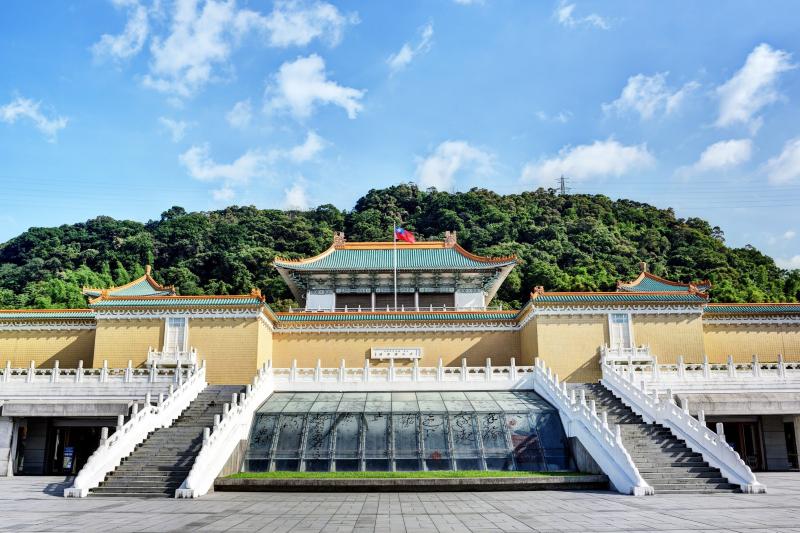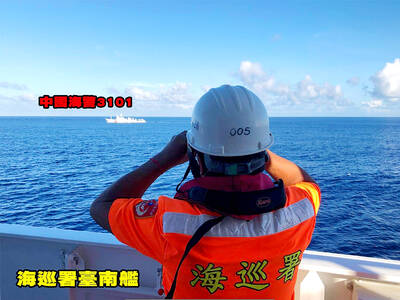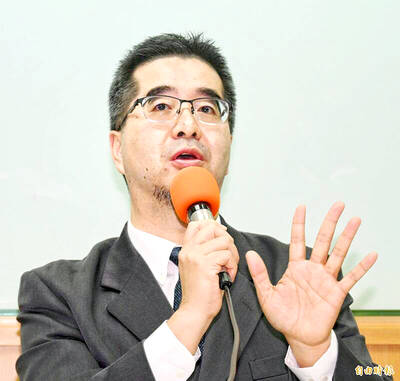The National Palace Museum, home to one of the world's biggest collections of imperial Chinese treasures, does not plan any joint events with China for its 100th anniversary due to Beijing's military threats, its director said today.
The museum was re-established in Taiwan in 1965 after the Republic of China government lost a civil war with Mao Zedong's (毛澤東) communists and fled to Taiwan in 1949, taking with them thousands of cases of antiques once owned by China's emperors.

Photo courtesy of the National Palace Museum
A competing institution remains in Beijing, the similarly named Palace Museum.
Speaking to reporters at the museum, National Palace Museum Director Hsiao Tsung-huang (蕭宗煌) said cooperation with Beijing's museum needed both sides to be willing to work together.
"Whether it is fighter jets, navy or civilian ships going up and down the Taiwan Strait, there is no opportunity like there was before for mutual friendliness or cooperation," he said, referring to China's almost daily military activities around Taiwan.
"We'd be happy to see it, but at the moment the other side has not taken the initiative to talk, and we even more cannot take the initiative to talk to them," Hsiao added.
The Palace Museum in Beijing did not immediately respond to a request for comment.
Instead, Taipei's museum is to send some of its collection to Prague and Paris this year, with the Qing Dynasty Jadeite Cabbage, one its most famous pieces which rarely leaves Taiwan, going on display at the Czech Republic's National Museum.
Next month, the National Palace Museum is to also host an exhibition of French impressionist and modernist art from New York's Metropolitan Museum of Art.
The National Palace Museum holds more than 690,000 items. More than 80 percent of them are from China's last dynasty, the former Qing court, which was overthrown in 1911.
A second branch of the museum opened in Chiayi County in 2015, and is being expanded to enable the public to see even more of the collection's artifacts.
It is to have a special focus on some of the museum's rarest pieces which Taiwan terms "national treasures."

The Coast Guard Administration (CGA) yesterday said it had deployed patrol vessels to expel a China Coast Guard ship and a Chinese fishing boat near Pratas Island (Dongsha Island, 東沙群島) in the South China Sea. The China Coast Guard vessel was 28 nautical miles (52km) northeast of Pratas at 6:15am on Thursday, approaching the island’s restricted waters, which extend 24 nautical miles from its shoreline, the CGA’s Dongsha-Nansha Branch said in a statement. The Tainan, a 2,000-tonne cutter, was deployed by the CGA to shadow the Chinese ship, which left the area at 2:39pm on Friday, the statement said. At 6:31pm on Friday,

The Chinese People’s Liberation Army Navy’s (PLAN) third aircraft carrier, the Fujian, would pose a steep challenge to Taiwan’s ability to defend itself against a full-scale invasion, a defense expert said yesterday. Institute of National Defense and Security Research analyst Chieh Chung (揭仲) made the comment hours after the PLAN confirmed the carrier recently passed through the Taiwan Strait to conduct “scientific research tests and training missions” in the South China Sea. China has two carriers in operation — the Liaoning and the Shandong — with the Fujian undergoing sea trials. Although the PLAN needs time to train the Fujian’s air wing and

Taiwanese celebrities Hank Chen (陳漢典) and Lulu Huang (黃路梓茵) announced yesterday that they are planning to marry. Huang announced and posted photos of their engagement to her social media pages yesterday morning, joking that the pair were not just doing marketing for a new show, but “really getting married.” “We’ve decided to spend all of our future happy and hilarious moments together,” she wrote. The announcement, which was later confirmed by the talent agency they share, appeared to come as a surprise even to those around them, with veteran TV host Jacky Wu (吳宗憲) saying he was “totally taken aback” by the news. Huang,

The American Institute in Taiwan (AIT) put Taiwan in danger, Ma Ying-jeou Foundation director Hsiao Hsu-tsen (蕭旭岑) said yesterday, hours after the de facto US embassy said that Beijing had misinterpreted World War II-era documents to isolate Taiwan. The AIT’s comments harmed the Republic of China’s (ROC) national interests and contradicted a part of the “six assurances” stipulating that the US would not change its official position on Taiwan’s sovereignty, Hsiao said. The “six assurances,” which were given by then-US president Ronald Reagan to Taiwan in 1982, say that Washington would not set a date for ending arm sales to Taiwan, consult